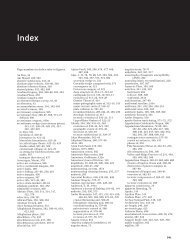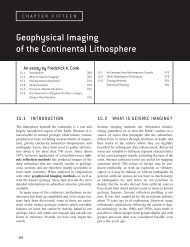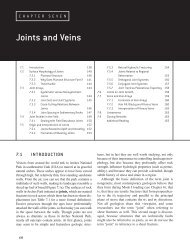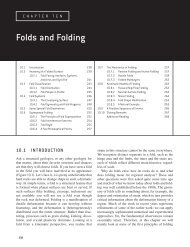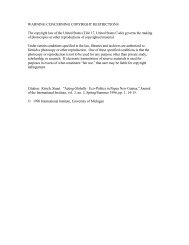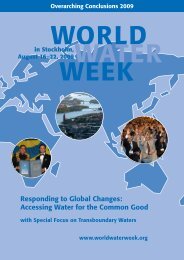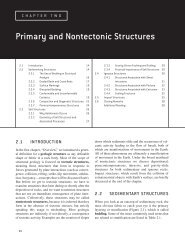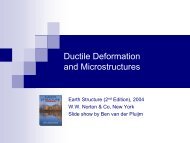742A.B. Weil et al. / Journal <strong>of</strong> Structural Geology 22 (2000) 735±756Table 1 (continued )Site No. Cores Tectonic Corrections In Situ Site Me<strong>an</strong>Strike Inv. Dip Dip Dir. Dip Dec(Low-Temp)Inc(Low-Temp)alpha 95 K Dec(High-Temp)Inc(High-Temp)alpha 95KSL77 b 5 14 104 46SL78 a 9 27 115 297 65 215 34 6 67SL79 a 6 50 100 320 80 220 6 5 220SL80 8 210 300 74 149 50 4 32SL81 6 332 62 70 154 8 4 244SL82 8 113 203 51 106 10 8 131a Designates overturned bedding.b Designates a site that could not be used (explained in text).c Designates a site that required great-circle <strong>an</strong>alysis.d Designates a site that required Ho€m<strong>an</strong> Day (1978) <strong>an</strong>alysis. (Dec, Inc) Represents paleomagnetic data not used in <strong>an</strong>alysis (explained intext).relative to the distributed magnetic vectors, such thatthe Euler pole <strong>of</strong> rotation was approximately 908away. This geometric con®guration resulted in theunique case where the best ®t small-circle is a great-circle.Note that we assume no signi®c<strong>an</strong>t rotation aboutthe axis <strong>of</strong> the (south-southeasterly <strong>an</strong>d shallow) magnetization,which c<strong>an</strong>not be detected <strong>by</strong> this <strong>an</strong>alysis.However, such a rotation would lead to recumbentfolds, which are not observed in our ®eld area orrecognized in the literature. Using the calculated F 3axes, F 3 de<strong>formation</strong> c<strong>an</strong> be removed <strong>an</strong>d the geometry<strong>of</strong> the CAA's hinge zone restored to the time <strong>of</strong>magnetic acquisition. Consequently, this correctionprocess constrains the kinematics <strong>of</strong> F 3 folding, as wellas a reconstruction <strong>of</strong> the CAA's geometry after F 2 de<strong>formation</strong>in the case <strong>of</strong> the B component, <strong>an</strong>d afterF 1 de<strong>formation</strong> in the case <strong>of</strong> the C component.4.2. La Queta SynclineThirteen sites were collected around the La QuetaDomain (Fig. 2). All sites are located in the PortillaFormation, which has continuous exposure around theentire structure. <strong>The</strong> in situ magnetic directions show acorrelation between site me<strong>an</strong> declination <strong>an</strong>d localstrike, <strong>an</strong>d <strong>an</strong> inclination pattern that r<strong>an</strong>ges frommainly upward in the south to steep <strong>an</strong>d downward inthe north (as listed in Table 1). Typical orthogonalprojection plots <strong>an</strong>d site me<strong>an</strong>s for the La Queta Synclineare shown in Figs. 5(a) <strong>an</strong>d 6. After removal <strong>of</strong> aviscous present-day ®eld overprint, one stable <strong>an</strong>cientcomponent was found within the La Queta Domain(Fig. 5a).<strong>The</strong> geometry <strong>of</strong> the La Queta Syncline only permitsfold tests on kilometer-scale folds. A total <strong>of</strong> four foldtests were performed: (1) on the southern tip; (2) onthe northeast corner; (3) on a north-wall interferencefold; <strong>an</strong>d (4) on the entire central zone <strong>of</strong> the mainsynclinal structure. In the southern tip <strong>of</strong> the La QuetaDomain the structure becomes tightened, <strong>an</strong>d thelimbs take on a (sub)parallel orientation. However,because <strong>of</strong> the magnetic declination scatter in thesouthern tip (sites PL26, PL31 <strong>an</strong>d PL32), it is onlypossible to perform <strong>an</strong> inclination test (Fig. 7a). <strong>The</strong>axis <strong>of</strong> the fold trends northwest±southeast <strong>an</strong>d isprobably related to F 1 <strong>an</strong>d F 2 de<strong>formation</strong> because <strong>of</strong>its orientation. At 35% unfolding, the inclinationscluster at +78 with a maximum kappa value <strong>of</strong> 149(Fig. 7a). This result is interpreted as a C componentthat is post-F 1 de<strong>formation</strong> but pre-F 2 <strong>an</strong>d -F 3 de<strong>formation</strong>.Similar fold tests were done on the smaller (sub)parallelfolds found in the northern <strong>an</strong>d northeasternregions <strong>of</strong> the syncline: between sites PL29 <strong>an</strong>d PL33,<strong>an</strong>d sites PL37 <strong>an</strong>d PL38 (Fig. 7b <strong>an</strong>d c). Upon correction(inclination only), sites PL29 <strong>an</strong>d PL33 cluster at35% unfolding with <strong>an</strong> inclination <strong>of</strong> +398(kappa=19,130), <strong>an</strong>d sites PL37 <strong>an</strong>d PL38 cluster at50% unfolding with <strong>an</strong> inclination <strong>of</strong> +358(kappa=10,747). Such high kappa values are caused<strong>by</strong> a high degree <strong>of</strong> clustering combined with a lownumber <strong>of</strong> sites. Both tests are statistically signi®c<strong>an</strong>tat the 95% con®dence level, <strong>an</strong>d are interpreted as a Cmagnetization that predates F 2 <strong>an</strong>d F 3 de<strong>formation</strong>.<strong>The</strong> ®nal fold test was done on the ®ve middle sites(PL27, PL28, PL30, PL35, <strong>an</strong>d PL36), where the insitumagnetic declinations <strong>an</strong>d local strikes are subparallelon both limbs, <strong>an</strong>d the inclinations exhibitconsiderable scatter, r<strong>an</strong>ging from +20 to ±278(Fig. 7d). At 40% unfolding the inclinations clusteredat +138 (kappa=25). <strong>The</strong> results <strong>of</strong> the four fold testsshow a consistent pattern <strong>of</strong> magnetization acquisitionprior to F 2 <strong>an</strong>d F 3 de<strong>formation</strong>. Given the de®nition<strong>of</strong> the C component as post-F 1 <strong>an</strong>d pre-F 2 <strong>an</strong>d -F 3 ,weinterpret the entire La Queta structure as carrying theC magnetization.<strong>The</strong>refore, the C magnetization is used as a rotationconstraint, to ®nd those structural corrections that
A.B. Weil et al. / Journal <strong>of</strong> Structural Geology 22 (2000) 735±756 743bring the in-situ magnetic directions into coincidencewith the reference C magnetization. <strong>The</strong>se structuralcorrections there<strong>by</strong> undo the de<strong>formation</strong> (tilts <strong>an</strong>d rotations)that the rocks have undergone since the acquisition<strong>of</strong> the C-component rem<strong>an</strong>ence (i.e. F 2 <strong>an</strong>d F 3folding). By iterating the possible fold geometries thatwould result in both the La Queta's present-day beddingattitudes <strong>an</strong>d its in-situ magnetic direction scatter,<strong>an</strong> optimum set <strong>of</strong> fold-axes were calculated to correctfor F 2 <strong>an</strong>d F 3 de<strong>formation</strong>.Using the best-®t rotation axis (Fig. 6c <strong>an</strong>d d), tiltcorrectedsite me<strong>an</strong>s <strong>an</strong>d post-rem<strong>an</strong>ence bedding attitudeswere calculated for the northern sites (PL29,PL33, PL34, PL35, PL37, <strong>an</strong>d PL38) <strong>an</strong>d southernsites (PL26, PL27, PL28, PL30, PL31, PL32, <strong>an</strong>dPL36) <strong>of</strong> the La Queta syncline (Fig. 6b). Whenapplied, these corrections create a broad north±southorientedsyncline with intermediately to steeply dippinglimbs, <strong>an</strong>d a slightly northward-plunging fold axis(Fig. 8), there<strong>by</strong> restoring the syncline to its post-F 1geometry (corrected bedding <strong>an</strong>d magnetic directionare listed in Table 2). <strong>The</strong> applied rotations, correcteddeclination, inclinations <strong>an</strong>d bedding are given inTable 2.4.3. La Vega de los Viejos SynclineTwenty-four sites were collected around the LaVega de los Viejos Domain (Fig. 3). Fifteen sitesare located in the S<strong>an</strong>ta Lucia Formation <strong>an</strong>d ninesites are located in the Portilla Formation. Of the24 sites, the four southernmost sites could not beinterpreted (SL56, SL57, SL59 <strong>an</strong>d SL60) due toclearly rotated bedding relative to regional trendscaused <strong>by</strong> complicated local fault rotation (Fig. 3).Both <strong>formation</strong>s have continuous exposure aroundFig. 5. Typical examples <strong>of</strong> orthogonal thermal demagnetization plots (Zijderveld, 1967) in in-situ coordinates from nine Devoni<strong>an</strong> limestonesamples from the Portilla <strong>an</strong>d S<strong>an</strong>ta Lucia <strong>formation</strong>s. Open (closed) symbols represent projections onto the vertical (horizontal) pl<strong>an</strong>e; demagnetizationtemperatures given in degrees Celsius. (a) La Queta Syncline samples. (b) La Vega de los Viejos Syncline samples. (c) Proza Anticlinesamples.



